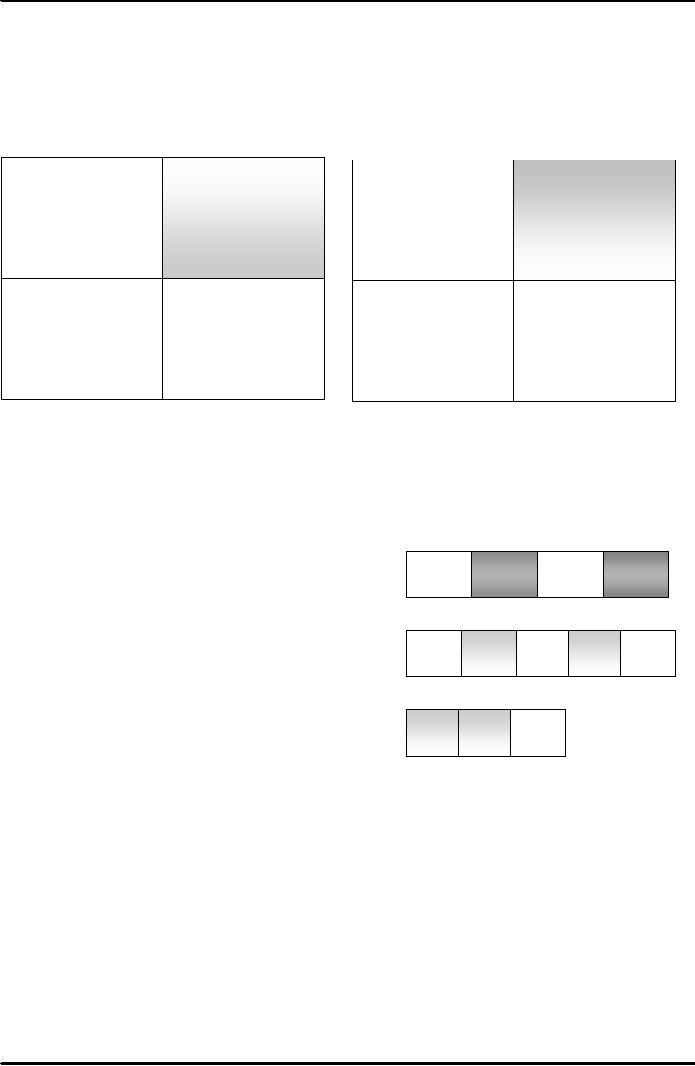 |
RESEARCH METHODS IN PSYCHOLOGY (II):Experimental Research |
| << RESEARCH METHODS IN PSYCHOLOGY (I):Scientific Nature of Psychology |
| PHYSICAL DEVELOPMENT AND NATURE NURTURE ISSUE:Nature versus Nurture >> |

Introduction
to Psychology PSY101
VU
Lesson
9
RESEARCH
METHODS IN PSYCHOLOGY (II)
e.
Content Analysis
�
Part
of archival research: An approach for
systematically categorizing and
analyzing the content
of
the behavior or its related
aspects/ variables being
studied.
�
The
analysis may cover contents
of live human behavior, books,
journals, magazines,
poetry,
drama,
movies, folktales, TV programs, school
textbooks and curricula,
advertisements etc.
�
Inferences
are made and conclusions
are drawn after objective identification of
specific
characteristics
of contents.
�
Content
analysis is done keeping specific goals,
objectives, themes and
constructs in mind.
�
Example:
Content analysis of textbooks
with reference to gender equity
and equality; analysis
of
TV programs with reference to portrayal
of women.
f.
Focus Groups
�
A
variety of interviews conducted in a group
setting.
�
The
researcher talks to the participants in
order to learn about their
opinions, attitudes,
preferences,
likes/dislikes and tries to
find out their
reasons/cause.
�
Used
as a source of data collection in
surveys but also used
otherwise as well.
g.
Meta Analysis
�
A
statistics based method
�
A
way of reviewing existing research literature in the
same field, about the same
phenomena
�
The
analysis covers the results of
several independent experiments within
the same field
�
Computer
aided statistical analysis
yields overall
conclusions
Experimental
Research
�
Experimental
method: the use of experimentation for studying a
phenomenon.
�
Experimental
design: the plan/structure/lay out of an
experiment.
�
Experiment:
the variable of interest (independent variable) is
manipulated/ altered and
the
effect
of this manipulation is studied.
Why
experiments are conducted?
�
For
testing hypotheses
�
To
test the impact of a treatment or a program on
behavior
�
The
main feature of experimentation is
CONTROL; keeping all those
variables and
conditions
under
control, that can have an
impact on the findings of the study
i.e., variables that
can
interfere
with the impact of the independent
variable.
Variables
i.
Independent Variable
ii.
Dependent Variable
iii.
Control Variable
Independent
Variable (IV): The
variable whose impact is being studied;
that is manipulated...in terms
of
kind
or level
Dependent
Variable (DV): The
measure of behavior on which the
impact of independent variable is
being
studied
Control
variable (CV): A
potential independent variable that can
have an impact upon dependent
variable;
it
has to be controlled
54

Introduction
to Psychology PSY101
VU
Groups
in a Typical Experiment
i.
Experimental Group: This is treated
with the independent variable.
ii.
Control Group; the no-treatment group
that is kept under controlled
conditions.
Classical
Experiment Design
Standard
format:
Example
of impact of music on
stress:
Ex.
group treated by soft
Ex.
group
Ex.
group treated by IV
Ex.
group
music
(IV)
measured
on
&
then measured on DV
measured
on
&
then measured on DV
DV
Stress
level(DV)
Cont.
group
Control.
group
Cont.
group
Control.
group
measured
on
measured
on
measured
on Stress
measured
on
DV
DV
level
(DV)
DV
Experimental
Designs
i.
Within- Subjects
Design
ii.
Between- Subjects
Design
Within
Subject Design
The
experimental design in which the subjects'
performance is compared with
their own performance
i.e.,
only
one group of subjects is
used.
Before-After
No Control Group Design:
A:
DV
B:
IV
A:
IV
B:
DV
Varieties
of Before-after no control group
designs:
ABABA
and ABABABBA
designs
A:
DV
B:
IV
A:
DV
B:
IV
A:
DV
Between
Subjects Experimental
Design
The
experimental design in which two or
more groups of
subjects
are
used and their performance
is compared with each
other:
B:
IV
B:
IV
A:
DV
i.
Classical Experimental
Design
ii.
After- Only Experimental
Design
Problems
associated with experimental
research:
�
Artificiality
of behavior is a possibility
�
Subjects
may be under stress or
pressure
�
Time
consuming and
expensive
�
Ethical
issues: can we tell all
about the nature of experiment to the
subjects???
BUT...the
very element of control
gives edge to this approach, as
this is what makes
psychology
a science.
Applied
Research: Quasi
Experimentation
�
Kind
of research that fits into
the experimental framework, although it is not
planned, initiated
or
controlled by the experimenter: it is "sort of
experimentation".
55

Introduction
to Psychology PSY101
VU
�
It
is the experimentation in which the independent variable
occurs, or has occurred,
naturally
and
the researcher studies its
impact the way it is done in a laboratory
experiment
Groups
in a Quasi- Experiment
i.
Exposure Group
ii.
Comparison Group
Quasi-
experimental Design
i.
Retrospective/Ex
Post Facto Design: Ex
post facto means "after the
fact". There are two
groups,
the exposure group and the
comparison group. The process of
"constructing" comparable
exposure
and comparison groups is
called "matching". The
subjects are already naturally
divided like
that.
However, the experimenter selects the relevant
subjects according to the nature of the
research.
ii.
Prospective
Design: This
design is similar to the retrospective
design, except that in a
prospective
design,
variations in the independent variable are measured as
they occur, rather than
retrospectively.
Researchers are equally
careful in interpreting the prospective
and retrospective
quasi-
experiments. In neither case, the
subjects are randomly assigned to the
exposure and the
control
groups. Generally, prospective
designs are more persuasive
than retrospective
designs,
especially
when the independent variable occurred long
ago
iii.
Time
series Design: This
design is mainly concerned with observing
whether the values of the
dependent
variable change in apparent response to
changes in an independent
variable.
Examples
of Quasi Experimentation
i.
Twin
Studies
Twin
studies investigate different
aspects of behavior and
mental processes of twins, whether
identical
or
fraternal. The studies on identical twins
reared apart have generated
very significant results. They
have
shown amazing similarities as
well as differences among
such twins.
ii.
Adoption
Studies
Most
people have one set of
parents. However 1% of the infants born
in western countries every
year
are
adopted at or near by persons unrelated to
them. Such children have
two sets of parents:
parents
who
rear them and those who give
them their genes. Social
scientists have used this to
help determine,
with
fascinating results, how
much influence genetic factors
and family environment have
over
behavior.
Like twin studies, adoption
studies suggested that many
human behaviors are
genetically
influenced.
That is why the nature- nurture
issue is always remaining
controversial.
Applied
Research: Single- Case Research
Designs
�
A
type of research in which a single
case is focused upon and
studied.
�
This
approach is employed in rarely occurring
cases.
56
Table of Contents:
- WHAT IS PSYCHOLOGY?:Theoretical perspectives of psychology
- HISTORICAL ROOTS OF MODERN PSYCHOLOGY:HIPPOCRATES, PLATO
- SCHOOLS OF THOUGHT:Biological Approach, Psychodynamic Approach
- PERSPECTIVE/MODEL/APPROACH:Narcosis, Chemotherapy
- THE PSYCHODYNAMIC APPROACH/ MODEL:Psychic Determinism, Preconscious
- BEHAVIORAL APPROACH:Behaviorist Analysis, Basic Terminology, Basic Terminology
- THE HUMANISTIC APPROACH AND THE COGNITIVE APPROACH:Rogers’ Approach
- RESEARCH METHODS IN PSYCHOLOGY (I):Scientific Nature of Psychology
- RESEARCH METHODS IN PSYCHOLOGY (II):Experimental Research
- PHYSICAL DEVELOPMENT AND NATURE NURTURE ISSUE:Nature versus Nurture
- COGNITIVE DEVELOPMENT:Socio- Cultural Factor, The Individual and the Group
- NERVOUS SYSTEM (1):Biological Bases of Behavior, Terminal Buttons
- NERVOUS SYSTEM (2):Membranes of the Brain, Association Areas, Spinal Cord
- ENDOCRINE SYSTEM:Pineal Gland, Pituitary Gland, Dwarfism
- SENSATION:The Human Eye, Cornea, Sclera, Pupil, Iris, Lens
- HEARING (AUDITION) AND BALANCE:The Outer Ear, Auditory Canal
- PERCEPTION I:Max Wertheimer, Figure and Ground, Law of Closure
- PERCEPTION II:Depth Perception, Relative Height, Linear Perspective
- ALTERED STATES OF CONSCIOUSNESS:Electroencephalogram, Hypnosis
- LEARNING:Motor Learning, Problem Solving, Basic Terminology, Conditioning
- OPERANT CONDITIONING:Negative Rein forcer, Punishment, No reinforcement
- COGNITIVE APPROACH:Approach to Learning, Observational Learning
- MEMORY I:Functions of Memory, Encoding and Recoding, Retrieval
- MEMORY II:Long-Term Memory, Declarative Memory, Procedural Memory
- MEMORY III:Memory Disorders/Dysfunctions, Amnesia, Dementia
- SECONDARY/ LEARNT/ PSYCHOLOGICAL MOTIVES:Curiosity, Need for affiliation
- EMOTIONS I:Defining Emotions, Behavioral component, Cognitive component
- EMOTIONS II:Respiratory Changes, Pupillometrics, Glandular Responses
- COGNITION AND THINKING:Cognitive Psychology, Mental Images, Concepts
- THINKING, REASONING, PROBLEM- SOLVING AND CREATIVITY:Mental shortcuts
- PERSONALITY I:Definition of Personality, Theories of Personality
- PERSONALITY II:Surface traits, Source Traits, For learning theorists, Albert Bandura
- PERSONALITY III:Assessment of Personality, Interview, Behavioral Assessment
- INTELLIGENCE:The History of Measurement of Intelligence, Later Revisions
- PSYCHOPATHOLOGY:Plato, Aristotle, Asclepiades, In The Middle Ages
- ABNORMAL BEHAVIOR I:Medical Perspective, Psychodynamic Perspective
- ABNORMAL BEHAVIOR II:Hypochondriasis, Conversion Disorders, Causes include
- PSYCHOTHERAPY I:Psychotherapeutic Orientations, Clinical Psychologists
- PSYCHOTHERAPY II:Behavior Modification, Shaping, Humanistic Therapies
- POPULAR AREAS OF PSYCHOLOGY:ABC MODEL, Factors affecting attitude change
- HEALTH PSYCHOLOGY:Understanding Health, Observational Learning
- INDUSTRIAL/ORGANIZATIONAL PSYCHOLOGY:‘Hard’ Criteria and ‘Soft’ Criteria
- CONSUMER PSYCHOLOGY:Focus of Interest, Consumer Psychologist
- SPORT PSYCHOLOGY:Some Research Findings, Arousal level
- FORENSIC PSYCHOLOGY:Origin and History of Forensic Psychology